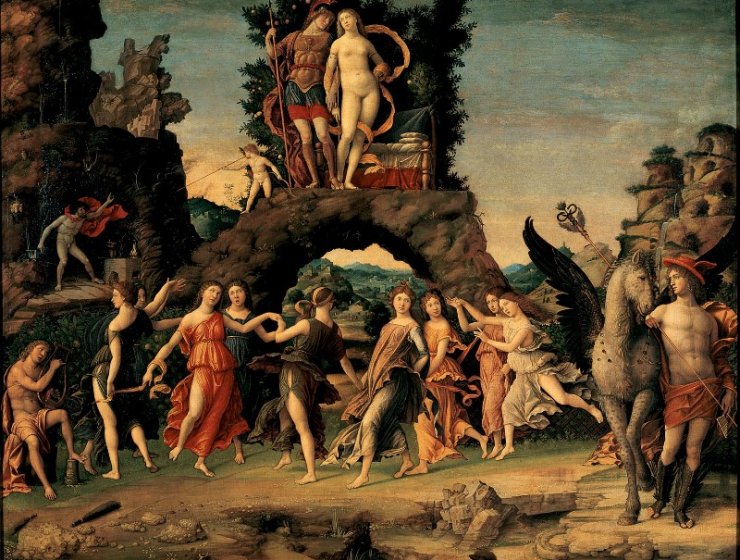
-Index-
Ars longa, vita brevis: the History of Art in the long term
José María SALVADOR GONZÁLEZ, Matheus Corassa da SILVA
Original title: Ars longa, vita brevis: a História da Arte na longa duração
The funeral banquet: iconographic analysis
Irene BENITO GONZÁLEZ
Original title: El banquete funerario: análisis iconográfico
The present article proposes an iconographic analysis through a series of images around the motive of the funeral banquet. This scene is enormously recurrent in the burials of Ancient Egypt, being one of the most important. The identification of this scene is given thanks to three key representations: the food, the dance along with the musical accompaniment, and the smell. In short, the scene of the funeral banquet is inevitably related to the idea of reaching a prosperous life after death.
The Annunciation as the locus of return of the figured logos
Alexandre Emerick NEVES
Original title: A Anunciação como o locus de retorno do logos figurado
The approximation of philosophical thought with theological precepts has brought about the conciliation of the presuppositions of Greco-Roman culture with Christian mysticism, of the concepts erected by rationalism with what is supposed divinely revealed, which seems to intuit the dimension of this event so represented in medieval aesthetics and Renaissance, namely, the annunciation of the logos taken as the divine virtue in the way of being fully revealed and manifested in the pictorial locus. More than a religious motif, it is the proclamation of a thought based on Aristotelian metaphysics, modeled on Stoicism and refined by Augustine and Thomas Aquinas, manifested in medieval aesthetics, especially in the retable of Simone Martini. The mystery of the incarnation intuits the convergence of the suprasensible with the world of appearances. Anticipated by the figuration of the Word announced, it presupposes the ontological status of origin and the speculative treatment of time, movement and place, from a comparative exercise between the descriptive aspects of the biblical narrative and its return figured in artistic beauty.
The monastery and the social function of religious architecture: the Cantiga 45 of the Cantigas de Santa Maria by king Alfonso X (13th century)
Bárbara DANTAS
Original title: O mosteiro e a função social da arquitetura religiosa: a Cantiga 45 das Cantigas de Santa Maria do rei Afonso X (século XIII)
D. Afonso wanted his obra maestra, the Cantigas de Santa Maria, to encompass everything that man sees and feels. And there is nothing more seen and felt than Architecture. Especially for us Religious Architecture. In Cantiga 45, the wise king presents us with a miracle report in which a knight, very affectionate to bad attitudes, wished to repair his errors and build a monastery dedicated to the Virgin Mary. His monastery would have all the rooms and spaces necessary for the monastic life.
The art as a temporal landmark in the Cathedral of Barcelona: tradition and innovation
Lorena da Silva VARGAS
Original title: A arte como marco temporal na Catedral de Barcelona: tradição e inovação
Among the corners of the gothic Cathedral (1298-1448) that prevails in the current landscape of Barcelona, there are artistic elements left by the time from the primitive paleochristian basilica, built in the 4th century A. D., passing through the visigoth church, by the romanesque and gothic cathedrals and entering the modernity until the recent history of the Cathedral of Barcelona. Here, we will seek to lift some of these temporal landmarks given by art over the centuries and which, preserved in the temple, tell the life of the Cathedral.
Figure and meaning of Venus in the artwork of Botticelli
Laura CASADO BALLESTEROS
Original title: Figura y significado de Venus en la obra de Botticelli
The representation of Venus in Botticelli’s painting has always been present, not only to reflect the goddess as another image, but as a representation in which the painter goes beyond the mythological theme that the goddess occupies, reflecting a whole series of elements that are part of the world of the symbol. As well as the importance of the philosophical lessons of Neoplatonic character in the subject that occupies to us, that already were object of debate in this epoch and will be us of great utility to establish a correct and coherent interpretation of the hidden message of these mythological works.
Gender perspectives: implementation of sociological methodology to Old Testament’s images of the 17th century
Irene BARRENO GARCÍA
Original title: Las perspectivas del género: aplicación de la metodología sociológica a imágenes veterotestamentarias del siglo XVII
The collective religious and artistic imagery of the seventeenth century is a fundamental point of study at the sociological level, since it shows thoughts and models that governed life in community of the time. For this reason, a study of these images is proposed in this paper with the aim of defending the following thesis: it is possible, with the tools provided by the main historians of art of the sociological school (such as Antal, Francastel, Hadjinicolaou or Hauser), argue that the use of one type or another of images of biblical women (positive or negative) may vary according to gender, understood as a social construct, of the subject performing the representation. In this way, works made by female and male painters will be contrasted on the basis of thematic blocks: Judith beheading Holofernes, Susana and the Elders, Jael and Sisera and Samson and Delilah. Each of the themes, as you can see, presents a conflicting episode that has as protagonists a duo formed by a man and a woman. In this way the opposing positions between the two genders will be much more evident, depending on the hand of the painter.


















































































